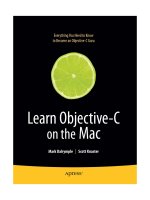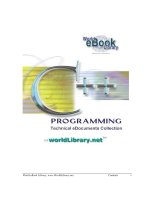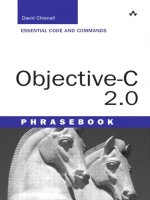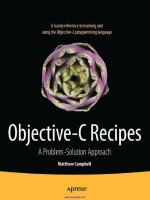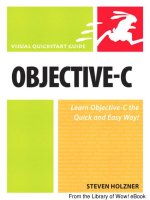objective C tutorial english ebook
Bạn đang xem bản rút gọn của tài liệu. Xem và tải ngay bản đầy đủ của tài liệu tại đây (2.42 MB, 186 trang )
Objective-C Tutorial
i
OBJECTIVE-C TUTORIAL
Simply Easy Learning by tutorialspoint.com
tutorialspoint.com
TUTORIALS POINT
Simply Easy Learning Page 1
ABOUT THE TUTORIAL
Objective-c tutorial
Objective-C is a general-purpose, object-oriented programming language that adds Smalltalk-style
messaging to the C programming language. This is the main programming language used by Apple for the
OS X and iOS operating systems and their respective APIs, Cocoa and Cocoa Touch.
This reference will take you through simple and practical approach while learning Objective-C Programming
language.
Audience
This reference has been prepared for the beginners to help them understand the basic to advanced concepts related
to Objective-C Programming languages.
Prerequisites
Before you start doing practice with various types of examples given in this reference, I'm making an
assumption that you are already aware about what is a computer program and what is a computer
programming language?
Compile/Execute Objective-C Programs
For most of the examples given in this tutorial, you will find Try it option to compile and execute Objective-C programs
online, so just make use of it and enjoy your learning.
Try the following example using Try it option available at the top right corner of the below sample code box:
#import <Foundation/Foundation.h>
int main()
{
/* my first program in Objective-C */
NSLog(@"Hello, World! \n");
return 0;
}
TUTORIALS POINT
Simply Easy Learning Page 2
Table of Content
Objective-c tutorial 1
Audience 1
Prerequisites 1
Compile/Execute Objective-C Programs 1
Objective-C Overview 9
Object-Oriented Programming 9
Example Code 9
Foundation Framework 9
Learning Objective-C 9
Use of Objective-C 10
Objective-C Environment Setup 11
Try it Option Online 11
Local Environment Setup 11
Text Editor 11
The GCC Compiler 11
Installation on UNIX/Linux 12
Installation on Mac OS 13
Installation on Windows 13
Objective-C Program Structure 14
Objective-C Hello World Example 14
Compile & Execute Objective-C Program: 15
Objective-C Basic Syntax 16
Tokens in Objective-C 16
Semicolons ; 16
Comments 16
Identifiers 17
Keywords 17
Whitespace in Objective-C 18
TUTORIALS POINT
Simply Easy Learning Page 3
Objective-C Data Types 19
Integer Types 19
Floating-Point Types 20
The void Type 21
Objective-C Variables 22
Variable Definition in Objective-C: 22
Variable Declaration in Objective-C: 23
Example 24
Lvalues and Rvalues in Objective-C: 25
Objective-C Constants 26
Integer literals 26
Floating-point literals 26
Character constants 27
String literals 28
Defining Constants 28
The #define Preprocessor 28
Objective-C Operators 30
Arithmetic Operators 30
Relational Operators 30
Logical Operators 31
Bitwise Operators 31
Assignment Operators 32
Misc Operators ↦ sizeof & ternary 33
Operators Precedence in Objective-C 33
Arithmetic Operators in Objective-C 35
Example 35
Relational Operators in Objective-C 37
Example 37
Logical Operators in Objective-C 39
Example 39
Bitwise Operators in Objective-C 41
Example 41
Assignment Operators in Objective-C 43
Example 44
Size of and ternary operators in Objective-C 46
Example 46
Objective-C Loops 48
Loop Control Statements: 49
The Infinite Loop: 49
TUTORIALS POINT
Simply Easy Learning Page 4
while loop in Objective-C 50
Syntax: 50
Flow Diagram: 50
Example: 51
For loop in Objective-C 52
Syntax: 52
Flow Diagram: 52
Example: 53
do while loop in Objective-C 54
Syntax: 54
Example: 55
nested loops in Objective-C 56
Syntax: 56
Example: 57
break statement in Objective-C 58
Syntax: 58
Flow Diagram: 58
Example: 59
continue statement in Objective-C 60
Syntax: 60
Flow Diagram: 60
Example: 61
Objective-C Decision Making 62
The ? : Operator: 63
Objective-C - if statement 64
Syntax: 64
Flow Diagram: 64
Example: 65
Objective-C - if else statement 66
Syntax: 66
Flow Diagram: 66
Example: 67
The if else if else Statement 67
Syntax: 67
Example: 68
Objective-C - nested if statements 69
Syntax: 69
Example: 69
Objective-C - switch statement 71
TUTORIALS POINT
Simply Easy Learning Page 5
Syntax: 71
Flow Diagram: 72
Example: 72
Objective-C - nested switch statements 74
Syntax: 74
Example: 75
Objective-C Functions 76
Defining a Method 76
Example: 77
Method Declarations: 77
Calling a method: 77
Function Arguments: 78
Function call by value in Objective-C 80
Function call by reference in Objective-C 82
Objective-C Blocks 84
Simple Block declaration syntax 84
Here is a simple example 84
We can invoke the block using 84
Blocks Take Arguments and Return Values 84
Blocks using type definitions 85
Objective-C Numbers 86
Objective-C Arrays 88
Declaring Arrays 88
Initializing Arrays 88
Accessing Array Elements 89
Objective-C Arrays in Detail 90
Multi-dimensional arrays in Objective-C 91
Two-Dimensional Arrays: 91
Initializing Two-Dimensional Arrays: 91
Accessing Two-Dimensional Array Elements: 92
Passing Arrays as Function Arguments in Objective-C 93
Way-1 93
Way-2 93
Way-3 93
Example 93
Return array from function in Objective-C 96
Pointer to an Array in Objective-C 99
Objective-C Pointers 101
What Are Pointers? 101
TUTORIALS POINT
Simply Easy Learning Page 6
How to use Pointers? 102
NULL Pointers in Objective-C 102
Objective-C Pointers in Detail: 103
Objective-C - Pointer arithmetic 104
Incrementing a Pointer 104
Decrementing a Pointer 105
Pointer Comparisons 105
Objective-C - Array of pointers 107
Objective-C - Pointer to Pointer 109
Passing pointers to functions in Objective-C 111
Return pointer from functions in Objective-C 113
Objective-C Strings 115
Objective-C Structures 118
Defining a Structure 118
Accessing Structure Members 119
Structures as Function Arguments 120
Pointers to Structures 121
Bit Fields 123
Objective-C Preprocessors 124
Preprocessors Examples 124
Predefined Macros 125
Preprocessor Operators 126
Macro Continuation (\) 126
Stringize (#) 126
Token Pasting (##) 126
The defined() Operator 127
Parameterized Macros 127
Objective-C Typedef 129
typedef vs #define 130
Objective-C Type Casting 131
Integer Promotion 131
Usual Arithmetic Conversion 132
Objective-C Log Handling 134
NSLog method 134
Disabling logs in Live apps 134
Objective-C Error Handling 135
NSError 135
Command-Line Arguments 138
Objective-C Classes & Objects 140
TUTORIALS POINT
Simply Easy Learning Page 7
Objective-C characteristics 140
Objective-C Class Definitions: 140
Allocating and initializing Objective-C Objects: 141
Accessing the Data Members: 141
Properties: 142
Objective-C Inheritance 143
Base & Derived Classes: 143
Access Control and Inheritance: 145
Objective-C Polymorphism 146
Objective-C Data Encapsulation 149
Data Encapsulation Example: 149
Designing Strategy: 150
Objective-C Categories 151
Characteristics of category 151
Objective-C Posing 153
Restrictions in Posing 153
Objective-C Extensions 155
Characteristics of extensions 155
Extensions Example 155
Objective-C Protocols 157
Objective-C Dynamic Binding 160
Objective-C Composite Objects 162
Class Clusters 162
So what's exactly composite object? 162
A Composite Object example 163
Obj-C Foundation Framework 165
Foundation Classes based on functionality 165
Data Storage in Objective-C 166
NSArray & NSMutableArray 166
NSDictionary & NSMutableDictionary 167
NSSet & NSMutableSet 168
Text and strings in Objective C 170
NSCharacterSet 170
Dates and times in Objective-C 172
Exception handling in Objective-C 173
File Handling in Objective-C 174
Methods used in File Handling 174
Check if file exists at a path 174
Comparing two file contents 174
TUTORIALS POINT
Simply Easy Learning Page 8
Check if writable, readable and executable 174
Move file 174
Copy file 175
Remove file 175
Read file 175
Write file 175
URL loading system in Objective-C 176
Objective-C Fast Enumeration 179
Collections in Objective-C 179
Fast enumeration Syntax 179
Fast Enumeration Backwards 180
Obj-C Memory Management 181
"Manual Retain-Release" or MRR 181
MRR Basic Rules 182
"Automatic Reference Counting" or ARC 183
TUTORIALS POINT
Simply Easy Learning Page 9
Objective-C Overview
Objective-C is general-purpose language that is developed on top of C Programming language by adding
features of Small Talk programming language making it an object-oriented language. It is primarily used in developing
iOS and Mac OS X operating systems as well as its applications.
Initially, Objective-C was developed by NeXT for its NeXTSTEP OS from whom it was taken over by Apple for its iOS
and Mac OS X.
Object-Oriented Programming
Fully supports object-oriented programming, including the four pillars of object-oriented development:
Encapsulation
Data hiding
Inheritance
Polymorphism
Example Code
Foundation Framework
Foundation Framework provides large set of features and they are listed below.
It includes a list of extended datatypes like NSArray, NSDictionary, NSSet and so on.
It consists of a rich set of functions manipulating files, strings, etc.
It provides features for URL handling, utilities like date formatting, data handling, error handling, etc.
Learning Objective-C
The most important thing to do when learning Objective-C is to focus on concepts and not get lost in language
technical details.
CHAPTER
1
#import <Foundation/Foundation.h>
int main (int argc, const char * argv[])
{
NSAutoreleasePool * pool = [[NSAutoreleasePool alloc] init];
NSLog (@"hello world");
[pool drain];
TUTORIALS POINT
Simply Easy Learning Page 10
The purpose of learning a programming language is to become a better programmer; that is, to become more
effective at designing and implementing new systems and at maintaining old ones.
Use of Objective-C
Objective-C, as mentioned earlier, is used in iOS and Mac OS X. It has large base of iOS users and largely increasing
Mac OS X users. And since Apple focuses on quality first and its wonderful for those who started learning Objective-
C.
TUTORIALS POINT
Simply Easy Learning Page 11
Objective-C Environment Setup
Try it Option Online
You really do not need to set up your own environment to start learning Objective-C programming language.
Reason is very simple, we already have set up Objective-C Programming environment online, so that you can
compile and execute all the available examples online at the same time when you are doing your theory work.
This gives you confidence in what you are reading and to check the result with different options. Feel free to
modify any example and execute it online.
Try the following example using Try it option available at the top right corner of the below sample code box:
For most of the examples given in this tutorial, you will find Try it option, so just make use of it and enjoy your
learning.
Local Environment Setup
If you are still willing to set up your environment for Objective-C programming language, you need the
following two softwares available on your computer, (a) Text Editor and (b) The GCC Compiler.
Text Editor
This will be used to type your program. Examples of few editors include Windows Notepad, OS Edit command,
Brief, Epsilon, EMACS, and vim or vi.
Name and version of text editor can vary on different operating systems. For example, Notepad will be used on
Windows, and vim or vi can be used on windows as well as Linux or UNIX.
The files you create with your editor are called source files and contain program source code. The source files
for Objective-C programs are typically named with the extension ".m".
Before starting your programming, make sure you have one text editor in place and you have enough
experience to write a computer program, save it in a file, compile it and finally execute it.
The GCC Compiler
The source code written in source file is the human readable source for your program. It needs to be
"compiled" to turn into machine language, so that your CPU can actually execute the program as per
instructions given.
CHAPTER
2
#import <Foundation/Foundation.h>
int main()
{
/* my first program in Objective-C */
NSLog(@"Hello, World! \n");
return 0;
}
TUTORIALS POINT
Simply Easy Learning Page 12
This GCC compiler will be used to compile your source code into final executable program. I assume you have
basic knowledge about a programming language compiler.
GCC compiler is available for free on various platforms and the procedure to set up on various platforms is
explained below.
Installation on UNIX/Linux
The initial step is install gcc along with gcc Objective-C package. This is done by:
The next step is to set up package dependencies using following command:
In order to get full features of Objective-C, download and install GNUStep. This can be done by downloading
the package from
Now, we need to switch to the downloaded folder and unpack the file by:
Now, we need to switch to the folder gnustep-startup that gets created using:
Next, we need to configure the build process:
Then, we can build by:
We need to finally set up the environment by:
We have a helloWorld.m Objective-C as follows:
$ su -
$ yum install gcc
$ yum install gcc-objc
$ yum install make libpng libpng-devel libtiff libtiff-devel libobjc libxml2 libxml2-devel libX11-devel
libXt-devel libjpeg libjpeg-devel
$ tar xvfz gnustep-startup tar.gz
$ cd gnustep-startup-
$ ./configure
$ make
$ . /usr/GNUstep/System/Library/Makefiles/GNUstep.sh
#import <Foundation/Foundation.h>
int main (int argc, const char * argv[])
{
NSAutoreleasePool * pool = [[NSAutoreleasePool alloc] init];
NSLog (@"hello world");
[pool drain];
return 0;
}
TUTORIALS POINT
Simply Easy Learning Page 13
Now, we can compile and run a Objective-C file say helloWorld.m by switching to folder containing the file
using cd and then using the following steps:
We can see the following output::
Installation on Mac OS
If you use Mac OS X, the easiest way to obtain GCC is to download the Xcode development environment from
Apple's web site and follow the simple installation instructions. Once you have Xcode set up, you will be able
to use GNU compiler for C/C++.
Xcode is currently available at developer.apple.com/technologies/tools/.
Installation on Windows
In order to run Objective-C program on windows, we need to install MinGW and GNUStep Core. Both are
available at gnustep.org/experience/Windows.html.
First, we need to install the MSYS/MinGW System package. Then, we need to install the GNUstep Core
package. Both of which provide a windows installer, which is self-explanatory.
Then to use Objective-C and GNUstep by selecting Start -> All Programs -> GNUstep -> Shell
Switch to the folder containing helloWorld.m
We can compile the program by using:
We can run the program by using:
We get the following output:
$ gcc `gnustep-config objc-flags` -L/usr/GNUstep/Local/Library/Libraries -lgnustep-base
helloWorld.m -o helloWorld
$ ./helloWorld
2013-09-07 10:48:39.772 tutorialsPoint[12906] hello world
$ gcc `gnustep-config objc-flags` -L /GNUstep/System/Library/Libraries hello.m -o hello -lgnustep-
base -lobjc
./hello.exe
2013-09-07 10:48:39.772 tutorials Point[1200] hello world
TUTORIALS POINT
Simply Easy Learning Page 14
Objective-C Program Structure
Before we study basic building blocks of the Objective-C programming language, let us look a bare minimum
Objective-C program structure so that we can take it as a reference in upcoming chapters.
Objective-C Hello World Example
A Objective-C program basically consists of the following parts:
Preprocessor Commands
Interface
Implementation
Method
Variables
Statements & Expressions
Comments
Let us look at a simple code that would print the words "Hello World":
CHAPTER
3
#import <Foundation/Foundation.h>
@interface SampleClass:NSObject
- (void)sampleMethod;
@end
@implementation SampleClass
- (void)sampleMethod{
NSLog(@"Hello, World! \n");
}
@end
int main()
{
/* my first program in Objective-C */
SampleClass *sampleClass = [[SampleClass alloc]init];
[sampleClass sampleMethod];
return 0;
}
TUTORIALS POINT
Simply Easy Learning Page 15
Let us look various parts of the above program:
1. The first line of the program #import <Foundation/Foundation.h> is a preprocessor command,
which tells a Objective-C compiler to include Foundation.h file before going to actual
compilation.
2. The next line @interface SampleClass:NSObject shows how to create an interface. It inherits
NSObject, which is the base class of all objects.
3. The next line - (void)sampleMethod; shows how to declare a method.
4. The next line @end marks the end of an interface.
5. The next line @implementation SampleClass shows how to implement the interface
SampleClass.
6. The next line - (void)sampleMethod{} shows the implementation of the sampleMethod.
7. The next line @end marks the end of an implementation.
8. The next line int main() is the main function where program execution begins.
9. The next line /* */ will be ignored by the compiler and it has been put to add additional
comments in the program. So such lines are called comments in the program.
10. The next line NSLog( ) is another function available in Objective-C which causes the message
"Hello, World!" to be displayed on the screen.
11. The next line return 0; terminates main()function and returns the value 0.
Compile & Execute Objective-C Program:
Now when we compile and run the program, we will get the following result.
2013-09-07 22:38:27.932 demo[28001] Hello, World!
TUTORIALS POINT
Simply Easy Learning Page 16
Objective-C Basic Syntax
You have seen a basic structure of Objective-C program, so it will be easy to understand other basic
building blocks of the Objective-C programming language.
Tokens in Objective-C
A Objective-C program consists of various tokens and a token is either a keyword, an identifier, a constant, a
string literal, or a symbol. For example, the following Objective-C statement consists of six tokens:
The individual tokens are:
Semicolons ;
In Objective-C program, the semicolon is a statement terminator. That is, each individual statement must be
ended with a semicolon. It indicates the end of one logical entity.
For example, following are two different statements:
Comments
Comments are like helping text in your Objective-C program and they are ignored by the compiler. They start
with /* and terminate with the characters */ as shown below:
You can not have comments with in comments and they do not occur within a string or character
literals.
CHAPTER
4
NSLog(@"Hello, World! \n");
NSLog
@
(
"Hello, World! \n"
)
;
NSLog(@"Hello, World! \n");
return 0;
/* my first program in Objective-C */
TUTORIALS POINT
Simply Easy Learning Page 17
Identifiers
An Objective-C identifier is a name used to identify a variable, function, or any other user-defined item. An
identifier starts with a letter A to Z or a to z or an underscore _ followed by zero or more letters, underscores,
and digits (0 to 9).
Objective-C does not allow punctuation characters such as @, $, and % within identifiers. Objective-C is a
case-sensitive programming language. Thus, Manpower and manpower are two different identifiers in
Objective-C. Here are some examples of acceptable identifiers:
Keywords
The following list shows few of the reserved words in Objective-C. These reserved words may not be used as
constant or variable or any other identifier names.
auto
else
long
switch
break
enum
register
typedef
case
extern
return
union
char
float
short
unsigned
const
for
signed
void
continue
goto
sizeof
volatile
default
if
static
while
do
int
struct
_Packed
double
protocol
interface
implementation
NSObject
NSInteger
NSNumber
CGFloat
property
nonatomic;
retain
strong
weak
unsafe_unretained;
readwrite
readonly
mohd zara abc move_name a_123
myname50 _temp j a23b9 retVal
TUTORIALS POINT
Simply Easy Learning Page 18
Whitespace in Objective-C
A line containing only whitespace, possibly with a comment, is known as a blank line, and an Objective-C
compiler totally ignores it.
Whitespace is the term used in Objective-C to describe blanks, tabs, newline characters and comments.
Whitespace separates one part of a statement from another and enables the compiler to identify where one
element in a statement, such as int, ends and the next element begins. Therefore, in the following statement:
There must be at least one whitespace character (usually a space) between int and age for the compiler to be
able to distinguish them. On the other hand, in the following statement,
no whitespace characters are necessary between fruit and =, or between = and apples, although you are free
to include some if you wish for readability purpose.
int age;
fruit = apples + oranges; // get the total fruit
TUTORIALS POINT
Simply Easy Learning Page 19
Objective-C Data Types
In the Objective-C programming language, data types refer to an extensive system used for declaring
variables or functions of different types. The type of a variable determines how much space it occupies in
storage and how the bit pattern stored is interpreted.
The types in Objective-C can be classified as follows:
S.N.
Types and Description
1
Basic Types:
They are arithmetic types and consist of the two types: (a) integer types and (b) floating-point types.
2
Enumerated types:
They are again arithmetic types and they are used to define variables that can only be assigned certain
discrete integer values throughout the program.
3
The type void:
The type specifier void indicates that no value is available.
4
Derived types:
They include (a) Pointer types, (b) Array types, (c) Structure types, (d) Union types and (e) Function types.
The array types and structure types are referred to collectively as the aggregate types. The type of a function
specifies the type of the function's return value. We will see basic types in the following section whereas other
types will be covered in the upcoming chapters.
Integer Types
Following table gives you details about standard integer types with its storage sizes and value ranges:
Type
Storage size
Value range
char
1 byte
-128 to 127 or 0 to 255
unsigned char
1 byte
0 to 255
signed char
1 byte
-128 to 127
int
2 or 4 bytes
-32,768 to 32,767 or -2,147,483,648 to 2,147,483,647
unsigned int
2 or 4 bytes
0 to 65,535 or 0 to 4,294,967,295
short
2 bytes
-32,768 to 32,767
unsigned short
2 bytes
0 to 65,535
long
4 bytes
-2,147,483,648 to 2,147,483,647
unsigned long
4 bytes
0 to 4,294,967,295
CHAPTER
5
TUTORIALS POINT
Simply Easy Learning Page 20
To get the exact size of a type or a variable on a particular platform, you can use the sizeof operator. The
expression sizeof(type) yields the storage size of the object or type in bytes. Following is an example to get the
size of int type on any machine:
When you compile and execute the above program, it produces the following result on Linux:
Floating-Point Types
Following table gives you details about standard float-point types with storage sizes and value ranges and their
precision:
Type
Storage size
Value range
Precision
float
4 byte
1.2E-38 to 3.4E+38
6 decimal places
double
8 byte
2.3E-308 to 1.7E+308
15 decimal places
long double
10 byte
3.4E-4932 to 1.1E+4932
19 decimal places
The header file float.h defines macros that allow you to use these values and other details about the binary
representation of real numbers in your programs. Following example will print storage space taken by a float
type and its range values:
When you compile and execute the above program, it produces the following result on Linux:
#import <Foundation/Foundation.h>
int main()
{
NSLog(@"Storage size for int : %d \n", sizeof(int));
return 0;
}
2013-09-07 22:21:39.155 demo[1340] Storage size for int : 4
#import <Foundation/Foundation.h>
int main()
{
NSLog(@"Storage size for float : %d \n", sizeof(float));
return 0;
}
2013-09-07 22:22:21.729 demo[3927] Storage size for float : 4
TUTORIALS POINT
Simply Easy Learning Page 21
The void Type
The void type specifies that no value is available. It is used in three kinds of situations:
S.N.
Types and Description
1
Function returns as void
There are various functions in Objective-C which do not return value or you can say they return void. A
function with no return value has the return type as void. For example, void exit (int status);
2
Function arguments as void
There are various functions in Objective-C which do not accept any parameter. A function with no
parameter can accept as a void. For example, int rand(void);
The void type may not be understood to you at this point, so let us proceed and we will cover these concepts
in upcoming chapters.
TUTORIALS POINT
Simply Easy Learning Page 22
Objective-C Variables
A variable is nothing but a name given to a storage area that our programs can manipulate. Each variable in
Objective-C has a specific type, which determines the size and layout of the variable's memory; the range of
values that can be stored within that memory; and the set of operations that can be applied to the variable.
The name of a variable can be composed of letters, digits, and the underscore character. It must begin with
either a letter or an underscore. Upper and lowercase letters are distinct because Objective-C is case-
sensitive. Based on the basic types explained in previous chapter, there will be the following basic variable
types:
Type
Description
char
Typically a single octet (one byte). This is an integer type.
int
The most natural size of integer for the machine.
float
A single-precision floating point value.
double
A double-precision floating point value.
void
Represents the absence of type.
Objective-C programming language also allows to define various other types of variables, which we will cover
in subsequent chapters like Enumeration, Pointer, Array, Structure, Union, etc. For this chapter, let us study
only basic variable types.
Variable Definition in Objective-C:
A variable definition means to tell the compiler where and how much to create the storage for the variable. A
variable definition specifies a data type and contains a list of one or more variables of that type as follows:
Here, type must be a valid Objective-C data type including char, w_char, int, float, double, bool or any user-
defined object, etc., and variable_list may consist of one or more identifier names separated by commas.
Some valid declarations are shown here:
CHAPTER
6
type variable_list;
int i, j, k;
char c, ch;
float f, salary;
double d;
TUTORIALS POINT
Simply Easy Learning Page 23
The line int i, j, k; both declares and defines the variables i, j and k; which instructs the compiler to create
variables named i, j and k of type int.
Variables can be initialized (assigned an initial value) in their declaration. The initializer consists of an equal
sign followed by a constant expression as follows:
type variable_name = value;
Some examples are:
extern int d = 3, f = 5; // declaration of d and f.
int d = 3, f = 5; // definition and initializing d and f.
byte z = 22; // definition and initializes z.
char x = 'x'; // the variable x has the value 'x'.
For definition without an initializer: variables with static storage duration are implicitly initialized with NULL (all
bytes have the value 0); the initial value of all other variables is undefined.
Variable Declaration in Objective-C:
A variable declaration provides assurance to the compiler that there is one variable existing with the given type
and name so that compiler proceed for further compilation without needing complete detail about the variable.
A variable declaration has its meaning at the time of compilation only, compiler needs actual variable
declaration at the time of linking of the program.
A variable declaration is useful when you are using multiple files and you define your variable in one of the
files, which will be available at the time of linking of the program. You will use extern keyword to declare a
variable at any place. Though you can declare a variable multiple times in your Objective-C program but it can
be defined only once in a file, a function or a block of code.
